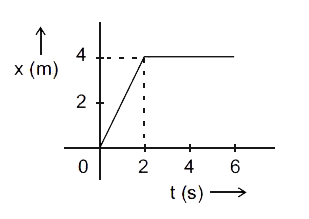Fig. shows the position-time graph of a particle of mass 4 kg. What is the (i) force acting on the particle for ? (ii) impulse at t = 0 and t = 4 s? Assume that the motion is one dimensional.
For No force as Particles is at rest.
For , No force again particle comes at rest.
For as slope of OA is constant so velocity constant i.e., a =0, so force must be zero.
(b) Impulse at t= 0
Impulse =change in momentum
Impulse at t=4s
Topper's Solved these Questions
- NEWTON'S LAWS OF MOTIONBook:CBSE COMPLEMENTARY MATERIALChapter:NEWTON'S LAWS OF MOTIONExercise:5 Marks Questions
Explore 2 Videos
- NEWTON'S LAWS OF MOTIONBook:CBSE COMPLEMENTARY MATERIALChapter:NEWTON'S LAWS OF MOTIONExercise:Laws Of Motion
Explore 20 Videos
- NEWTON'S LAWS OF MOTIONBook:CBSE COMPLEMENTARY MATERIALChapter:NEWTON'S LAWS OF MOTIONExercise:2 Mark Questions
Explore 14 Videos
- MECHANICAL WAVESBook:CBSE COMPLEMENTARY MATERIALChapter:MECHANICAL WAVESExercise:MCQ
Explore 20 Videos
- PROPERTIES OF MATTERBook:CBSE COMPLEMENTARY MATERIALChapter:PROPERTIES OF MATTERExercise:MULTIPLE CHOICE QUESTIONS (MCQs)
Explore 20 Videos
Similar Questions
Shown the position time graph of a particle of mass 4 kg What is the force on the particle for t<0,0<t<4s motion only
 .
.
View SolutionFig. shows the position-time graph of a particle of mass 4 kg. What is the (i) force acting on the particle for t<0,t<4s,0<t<4s? (ii) impulse at t = 0 and t = 4 s? Assume that the motion is one dimensional.
View Solution
Knowledge Check
Figure shows the position time graph of a particle of mass 5kg. The force acting on the particle for 0<t<4s and 8s<t<12s respectively are,
 A5N,5NB5N.7.5NC5N,10ND0N,0N
A5N,5NB5N.7.5NC5N,10ND0N,0NPosition time graph of a particle of mass 2 kg is shown in figrure. Total work done on the particle from t=0 to t=4s is
 A8 JB4 JC0 JDCan't be determined
A8 JB4 JC0 JDCan't be determinedFigure shows the position-time graph of a particle of mass 4kg. Let the force on the particle for t<0 , 0<tlt,4s , t>4s be F1,F2 and F3 respectively. Then
 AF1=F2=F3=0BF1>F2=F3CF1>F2>F3DF1<F2<F3
AF1=F2=F3=0BF1>F2=F3CF1>F2>F3DF1<F2<F3
The position-time graph of a particle of mass 0.1 kg is shown. The impulse at t = 2s is :

View SolutionShows position time graph of a particle of mass 100g Find the impulse at t=0 and at t=4s
 .
.
View SolutionThe position time graph of a body of mass 2kg is as given in What is the impulse on the body at t=0 s and t=4s ?
 .
.
View SolutionThe position-time graph of a particle of mass 0.1 kg is shown. The impulse at t = 2s is :

View SolutionIn the figure given, the position-time graph of a particle of mass 0.1 kg is shown the impulse at t = 2s is

View Solution